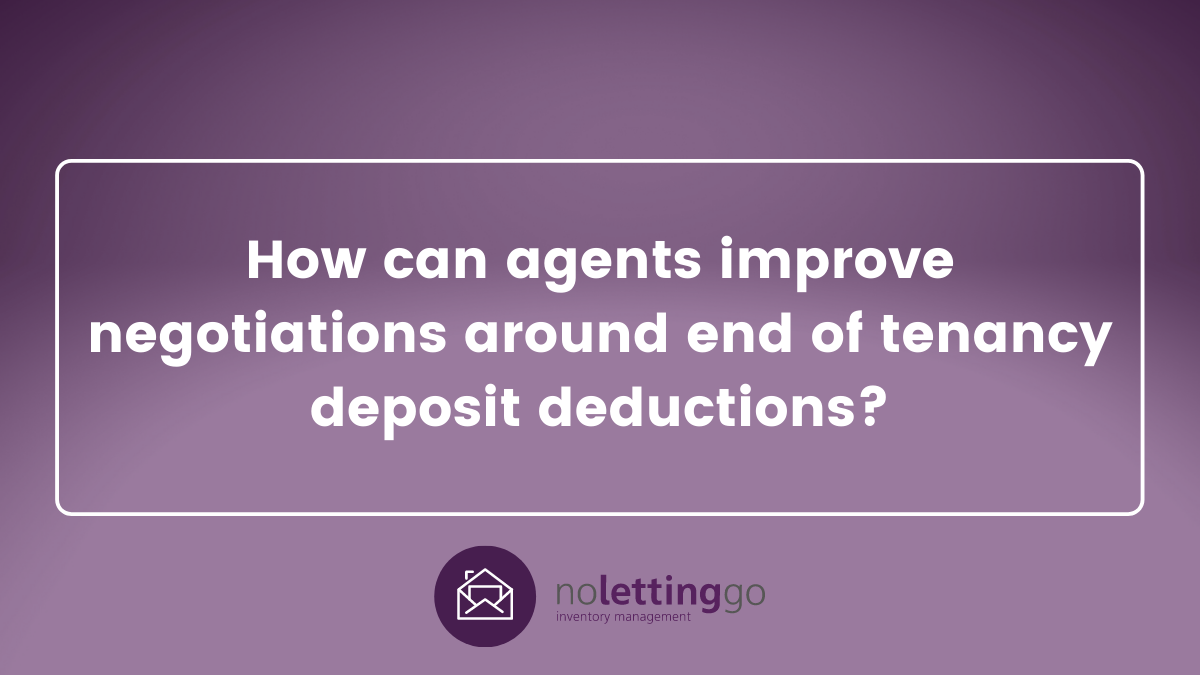The TDS annual review 2020, indicates that deposit disputes have remained low over the last year, at around 1%. This is great news for the industry, demonstrating professional standards are being upheld for both landlords and tenants. Good quality inventory management is pivotal in ensuring disputes remain low, but these figures only illustrate a snapshot of the work that goes into this part of the tenancy process. Many agents are committed to educating both tenants and landlords about the end of tenancy process, to avoid customers having a poor experience at the end of their tenancy journey, and to enable a smooth transition to the next tenancy. Agents can spend copious amounts of time with some tenancies negotiating with both parties to ensure complaints do not escalate into a formal dispute.
No Letting Go conduct thousands of inventory management reports a month, so inevitably we get involved in some areas of end-of-tenancy disputes. Our complaints run at less than 1% and the majority of these are fairly easy to resolve. However, there are some complaints that take up a lot of time, and it is seldom through lack of evidence and documentation.
The main cause of time-consuming disputes, often arise from the assumption that the deposit is like an insurance policy – it is designed to put the landlord in the same or similar position they were in at the start of the tenancy, and inventory management is the tool to ensure this happens.
It is difficult to find another service/industry that resembles rental property deposits, so let’s look through the lens of an inexperienced landlord, or one who has not experienced many dilapidations in a property previously:
- You cannot claim for fair wear and tear, but there are lots of variables that determine “fair” – such as, number of tenants, length of tenancy, where abouts wear and tear has occurred in the house, 3cm scratch v 6cm etc.
- Everything in the house has a different lifespan, so you must first grade the quality and then factor this into an apportionment calculation.
- You can claim for damage to a carpet, but just the isolated area of damage, not the whole carpet, so probably cannot be satisfactorily fixed – which doesn’t make a lot of sense to many landlords
- Landlords say “but it was disgusting/filthy”, but it is against industry best practice to use such terms, so we sanitize it to “poorly cleaned” – makes sense to us, but not to an irate landlord who is facing a ruined property.
I can add a much longer list and I’m sure you can too! The point is that frustrated landlords take up a lot of time for an agent when upset and frustrated – the rules of engagement for deposit claims make sense to those experienced within the industry, but the reality is they are not straightforward. So, I do sympathise with landlords, and particularly their agents who are trying to negotiate and satisfactorily resolve issues for their customers.
The number of complaints that take days to resolve is thankfully small. Of course, most agents have their own robust processes in place, but what additional tools can be used to smooth the way of a potential dispute arising, and ensure both parties are adequately informed. Aggrieved parties leave bad reviews, so education is the best ambassador:-
1. Grading Cleanliness – Rather than just saying “clean condition” have a comprehensive glossary of terms. No Letting Go has 6 within its glossary, as it is the most disputed item.
2. Proof of pre-tenancy cleaning – Adjudication data indicates that landlords/agents often do not provide evidence that show properties were professionally cleaned at the start – particularly for ovens and carpets.
3. Mid-term visits – Really helpful for landlord’s to prove they have taken steps to look after their properties and where appropriate given tenants advice on their tenancy obligations.
4. Copies of all communications – crucial to show that tenants’ maintenance requests have been acted upon and/or to advise tenants of theirs – keep copies of all text/WhatsApp messages as well as emails.
5. Evidence that Inventory was sent to tenants - Particularly relevant now, where there are very few accompanied Check Ins – landlords must be able to evidence the Inventory was sent to the tenants together with follow up emails if they do not sign/return it
6. Deposit Deduction Template – Deposit providers offer this to be used for both landlord and tenant, it provides an excellent structure so both parties can understand how the process works by viewing and adding comments (and will form the basis of a claim if all else fails).
7. A Guide to Product Lifespans – This is an excellent aid to share with landlords with a longer than average tenancy, or where the property was in “average” or below condition at the start of the tenancy – good to pre-empt a potential problem.
8. A Guide to Fair Wear and Tear – Useful for both tenants and landlords to understand what is fair and what is excessive – I have attached the No Letting Go guide but A Guide to Deposits, Disputes & Damages is also very useful
9. Pre check out report – Will highlight what items the tenant needs to address ahead of the end of tenancy, useful for certain types of tenant
10. The Depositary – All end of tenancy documentation is stored in one place and provides updates and a summary of deductions – an automated version of the Template above (No Letting Go are integrated with Depositary so our check out dilapidations for example, upload directly into the system).
Visit the No Letting Go landing page for more information and to see reviews, Click here
Visit the Tenancy Deposit Scheme (TDS) landing page for more information and to see reviews, Click here



